中国组织工程研究 ›› 2019, Vol. 23 ›› Issue (27): 4420-4428.doi: 10.3969/j.issn.2095-4344.1396
• 组织构建循证医学 evidence-based medicine in tissue construction • 上一篇
传统太极功法干预对改善骨密度流失疗效及安全性的系统评价
曾令烽1,2,3,杨伟毅1,梁桂洪1,3,陈红云1,郭 达1,罗明辉1,潘建科1,赵 第2,赵金龙2,黄和涛2,韩燕鸿2,林炯同2,侯森荣2,吴 明2,李嘉晖2,梁伟雄1,欧爱华1,刘 军1,2,3
- (1广州中医药大学第二附属医院(广东省中医院),广东省广州市 510120;2广州中医药大学第二临床医学院/博士后科研流动站,广东省广州市 510405;3广东省中医药科学院,骨与关节退变及损伤研究团队,广东省广州市 510120)
Systematic review on the efficacy and safety of Tai Chi of traditional body refreshment for improving bone mineral density loss
Zeng Lingfeng1, 2, 3, Yang Weiyi1, Liang Guihong1, 3, Chen Hongyun1, Guo Da1, Luo Minghui1, Pan Jianke1, Zhao Di2, Zhao Jinlong2, #br# Huang Hetao2, Han Yanhong2, Lin Jiongtong2, Hou Senrong2, Wu Ming2, Li Jiahui2, Liang Weixiong1, Ou Aihua1, Liu Jun1, 2, 3
- (1the Second Affiliated Hospital of Guangzhou University of Chinese Medicine (Guangdong Provincial Hospital of Chinese Medicine), Guangzhou 510120, Guangdong Province, China; 2the Second Clinical Medical College of Guangzhou University of Chinese Medicine/Post-Doctoral Research Station, Guangzhou 510405, Guangdong Province, China; 3Bone and Joint Research Team of Degeneration and Injury, Guangdong Provincial Academy of Chinese Medical Sciences, Guangzhou 510120, Guangdong Province, China)
摘要:
.jpg)
文题释义:
传统太极功法:主要包括太极拳、太极柔力球、太极推手等,融武术、气功、导引于一体,动静结合,形神共养;拳理中涵括着动静与阴阳,是既统一又对立,彼此消长和转化的一种健体养生运动。
骨健康传统太极功法健康促进模式:从现代医学角度分析,骨健康传统太极功法健康促进模式侧重于:①力学调控模式;②神经-心理-免疫调控模式;③化学调控模式。其中,力学调控模式归属于“外在调控”,其关注点在于:传统太极功法习练过程所形成的应力作用于人体骨骼本身,从而发挥健骨效应;神经-心理-免疫调控模式和化学调控模式,归属为“内在调控”,其核心涵义在于:通过心理健康调节、以及养气合神统一,进而促进人体内部各项机能处于最优态势,进而对习练者的骨骼健康状况发挥正向的调节效应。上述三大调控模式,彼此之间既互相独立,又互相影响;各体系最大化的发挥效应,且在体系之间保持和谐的运作方式,才能够更佳的改善人体的骨骼健康。
背景:当前针对患者骨健康/骨密度相关疾患结局指标的影响,传统太极功法干预仍然存在较大的争议,亟待作进一步探讨。
目的:系统评价传统太极功法干预对改善骨密度流失的临床疗效与安全性。
方法:通过计算机对中国知网CNKI、万方、维普VIP和中国生物医学文献数据库、以及国外数据库PubMed、MEDLINE、EMbase、Cochrane Library等进行全面检索;配合对大学图书馆的馆藏期刊进行手工检索,检索时间截于2019年1月;系统搜集传统太极功法(包括太极拳、太极推手、太极柔力球等)干预对骨健康/骨密度相关疾患结局指标影响的随机对照研究(RCT)文献。参考Cochrane系统评价方法进行文献筛选、资料提取以及方法学质量评价;并采用RevMan 5.3软件进行Meta分析。
结果与结论:共纳入14篇文献(16个RCT研究),Meta分析结果表明:接受传统太极功法干预后,脊柱腰椎L2-4骨密度(SMD=0.40,95%CI[0.16,0.65],P=0.001)、以及股骨颈骨密度(SMD=0.75,95% CI [0.27,1.24],P=0.002)改善方面均优于对照组;然而在Ward's三角骨密度(SMD=0.50,95%CI[-0.10,1.10],P=0.10)、股骨干骨密度(SMD=0.16,95%CI[-0.11,0.44],P=0.25)、股骨近端转子骨密度(SMD=0.54,95%CI[-0.01,1.09],P=0.05)、以及桡骨远端1/3处骨密度(SMD=0.20,95%CI[-0.26,0.66],P=0.040)与对照组比较,组间差异无统计学意义;且传统太极功法干预尚未发现严重不良事件。当前证据发现,传统太极功法干预在特定人群(例如老年人、骨质疏松人群、围绝经期与绝经后妇女)脊柱腰椎、股骨颈等部位的骨密度流失改善方面疗效明确,不良反应较少。鉴于纳入文献数量偏少以及研究本身局限性,有待开展高质量的、设计严谨的临床试验予以进一步验证。
中图分类号:
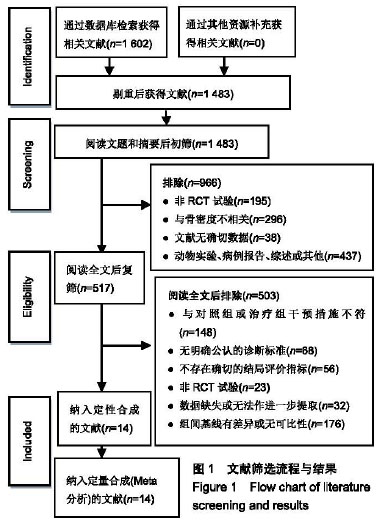
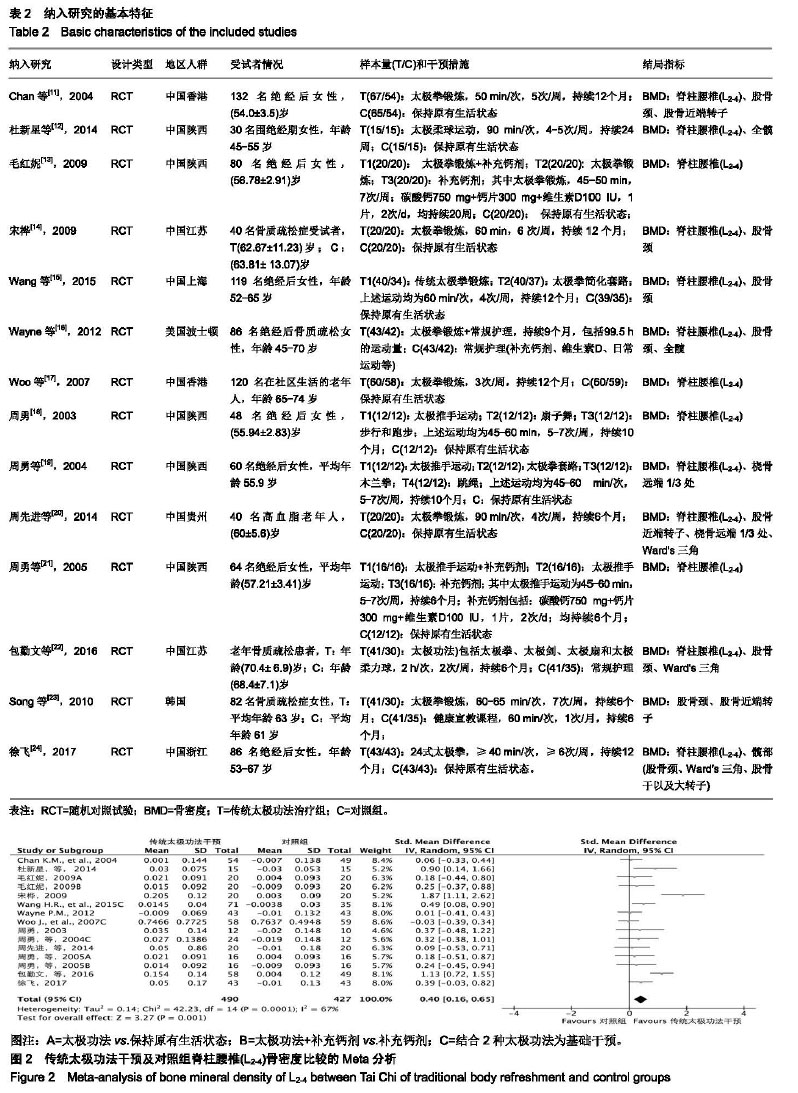
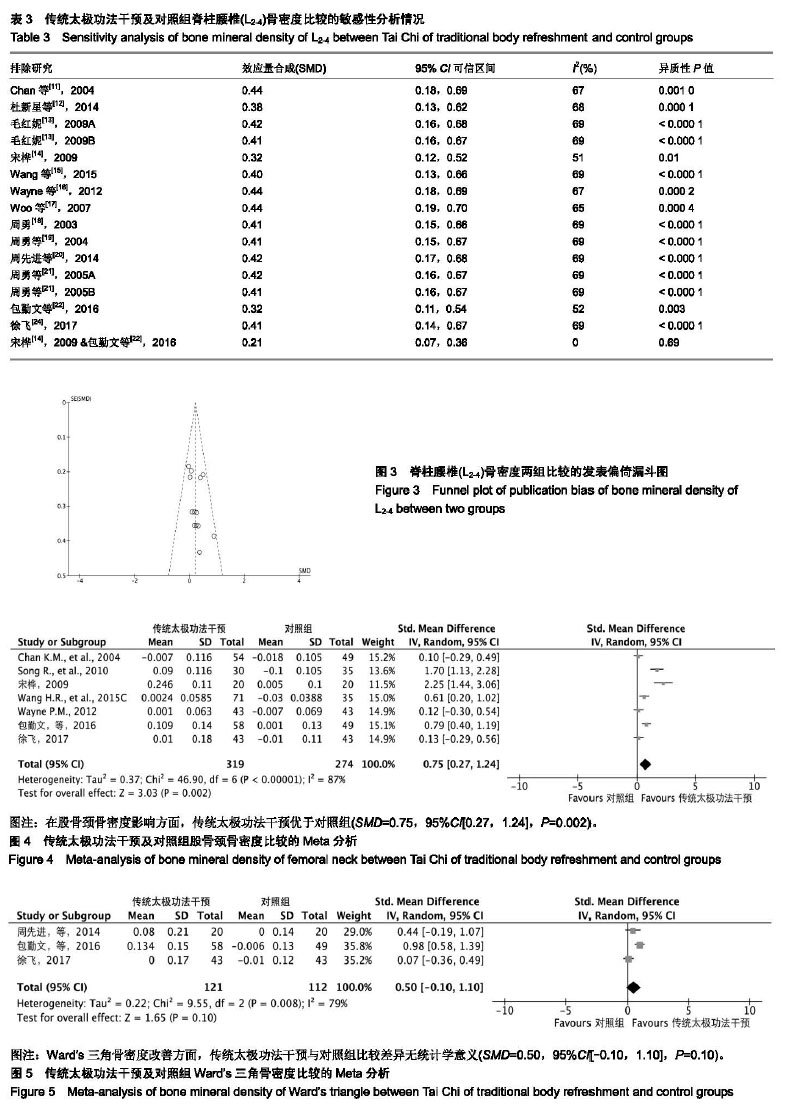
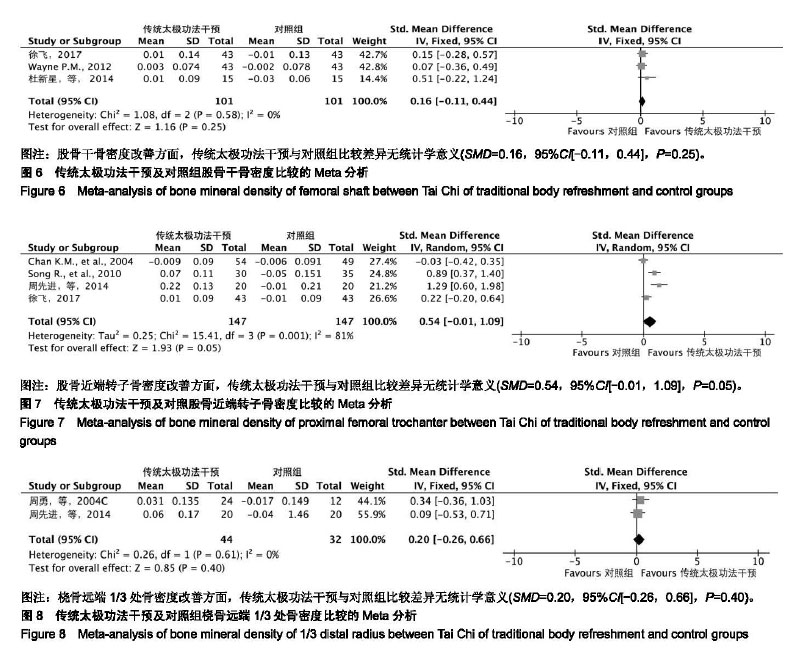
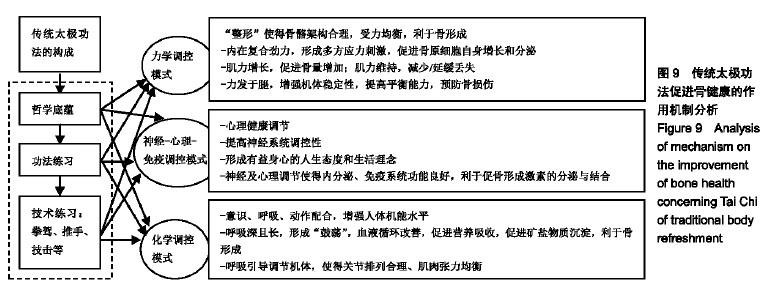
.jpg)
.jpg) #br#
文题释义:#br#
传统太极功法:主要包括太极拳、太极柔力球、太极推手等,融武术、气功、导引于一体,动静结合,形神共养;拳理中涵括着动静与阴阳,是既统一又对立,彼此消长和转化的一种健体养生运动。#br#
骨健康传统太极功法健康促进模式:从现代医学角度分析,骨健康传统太极功法健康促进模式侧重于:①力学调控模式;②神经-心理-免疫调控模式;③化学调控模式。其中,力学调控模式归属于“外在调控”,其关注点在于:传统太极功法习练过程所形成的应力作用于人体骨骼本身,从而发挥健骨效应;神经-心理-免疫调控模式和化学调控模式,归属为“内在调控”,其核心涵义在于:通过心理健康调节、以及养气合神统一,进而促进人体内部各项机能处于最优态势,进而对习练者的骨骼健康状况发挥正向的调节效应。上述三大调控模式,彼此之间既互相独立,又互相影响;各体系最大化的发挥效应,且在体系之间保持和谐的运作方式,才能够更佳的改善人体的骨骼健康。
#br#
文题释义:#br#
传统太极功法:主要包括太极拳、太极柔力球、太极推手等,融武术、气功、导引于一体,动静结合,形神共养;拳理中涵括着动静与阴阳,是既统一又对立,彼此消长和转化的一种健体养生运动。#br#
骨健康传统太极功法健康促进模式:从现代医学角度分析,骨健康传统太极功法健康促进模式侧重于:①力学调控模式;②神经-心理-免疫调控模式;③化学调控模式。其中,力学调控模式归属于“外在调控”,其关注点在于:传统太极功法习练过程所形成的应力作用于人体骨骼本身,从而发挥健骨效应;神经-心理-免疫调控模式和化学调控模式,归属为“内在调控”,其核心涵义在于:通过心理健康调节、以及养气合神统一,进而促进人体内部各项机能处于最优态势,进而对习练者的骨骼健康状况发挥正向的调节效应。上述三大调控模式,彼此之间既互相独立,又互相影响;各体系最大化的发挥效应,且在体系之间保持和谐的运作方式,才能够更佳的改善人体的骨骼健康。